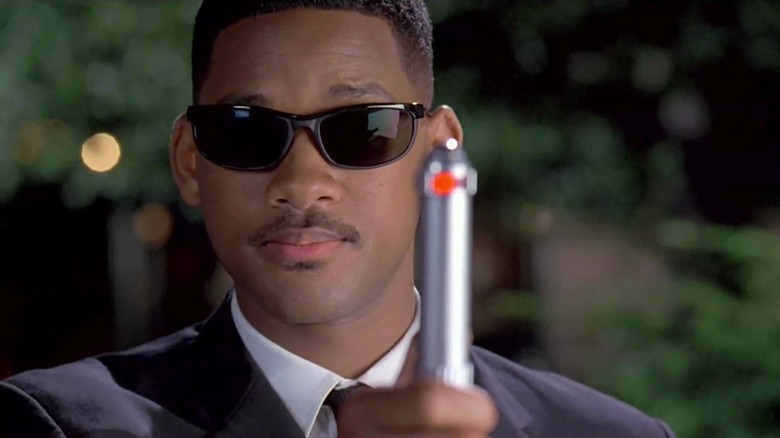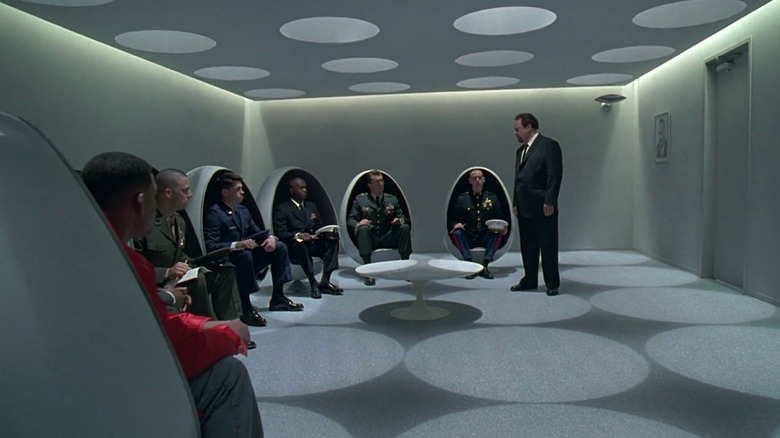Men In Black's Visual Style Supposedly Came From Stanley Kubrick
Filmmaker Barry Sonnenfeld has enjoyed one of the more diverse and wide-ranging oeuvres of any director in Hollywood. The multi-hyphenate artist is responsible for directing widely loved hits such as 1991's "The Addams Family" and especially "Men in Black" in 1997 — although the less said about the uneven sequel, the better. He also thrived in the '80s and '90s as the cinematographer for a number of Coen brother films ("Blood Simple," "Raising Arizona," "Miller's Crossing"), along with other enduring staples like "Big" and "When Harry Met Sally." With such a wealth of filmmaking insights over such a varied career, Sonnenfeld's hugely influential work has inevitably been emulated by countless others in the years since. But what about his own sources of inspiration that helped define his work in the first place?
In an interview with Nerdist published back when Sonnenfeld was set to release "Men in Black 3" in 2012, the outlet broached how much he has "informed many modern films and comedies." In his response, the director points out that many films in the years since have largely gone in their own separate direction:
"I find that most modern comedies are shot with multiple cameras and not particularly good lighting, because they're shooting for multiple angles at the same time. There are pieces of noses and awkward angles, and I find most modern comedies almost aggressively shot without any visual style. For me, I just don't see that way, I'm sort of a control guy. I shoot single camera, line up the shots, line up the eye lines."
It's not terribly surprising that Sonnenfeld would hold the genre to such high standards. But having made his bones in various comedies, would anyone have guessed that his visual style is indebted to Stanley Kubrick, of all directors?
Learning from the best
Nobody is more aware of the fascinating contradictions behind his own chosen niche as a director and his biggest influence than Barry Sonnenfeld is. In the same interview with Nerdist, the director goes on to describe how it came to be that his visual style owes itself to one of the greatest filmmakers of all time:
"I will say, I think it's a specific look that I sometimes see in other directors or cinematographers. I've always been a wide-angle guy, but my inspiration was 'Dr. Strangelove.' I mean, Kubrick didn't move the camera the way I use the camera and he doesn't sort of use the camera as a participant in the movie the way I do, but in terms of the formal framing and the tableau and the use of master shots to stay on when it's working and not to overcut a scene — those are things I learned from Kubrick, weirdly enough. You wouldn't call him necessarily a comic genius."
While this writer would quibble somewhat with that description (this article by /Film's Bill Bria succinctly addresses the topic), it's hard to argue with Sonnenfeld's assertion that, on the surface, he wouldn't necessarily appear to share much in common with Stanley Kubrick. As always, however, it's important to look beneath the most obvious layers of filmmaking in an attempt to discern exactly what a director like Sonnenfeld is trying to accomplish. It may not be very easy to look at a film like "Men in Black" and point out the Kubrickian influences of it all, but a more comprehensive look at his filmography might reveal a consistent through-line that bears a neat resemblance to Kubrick's preferred approach.
You just never know how exactly inspiration will strike, regardless of genre or tone. Barry Sonnenfeld is living proof.

